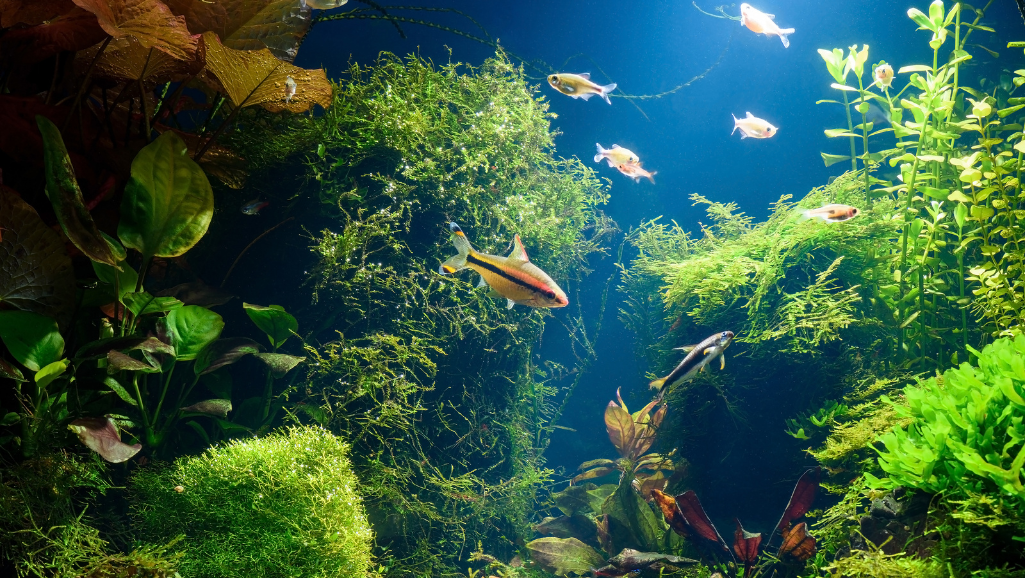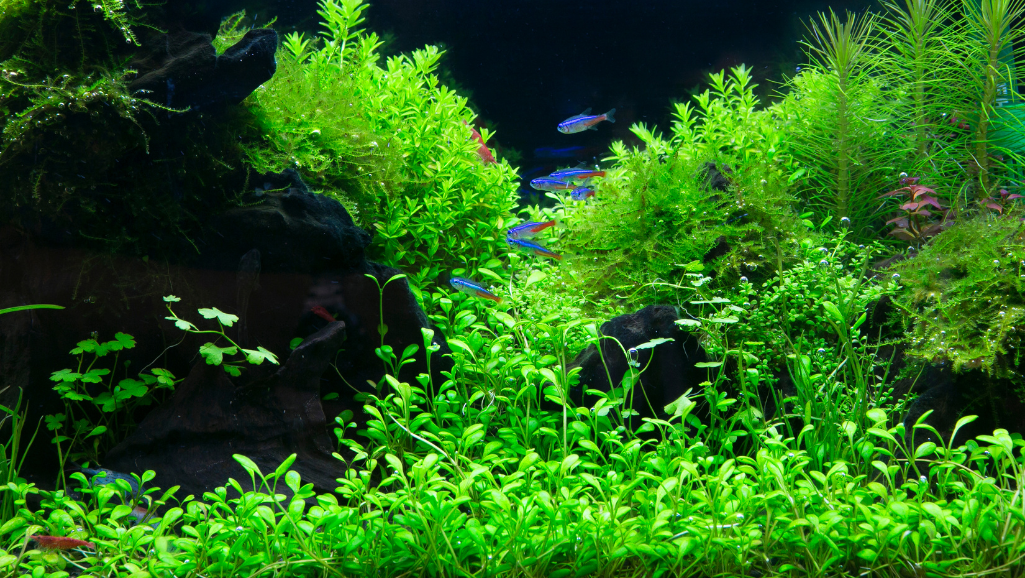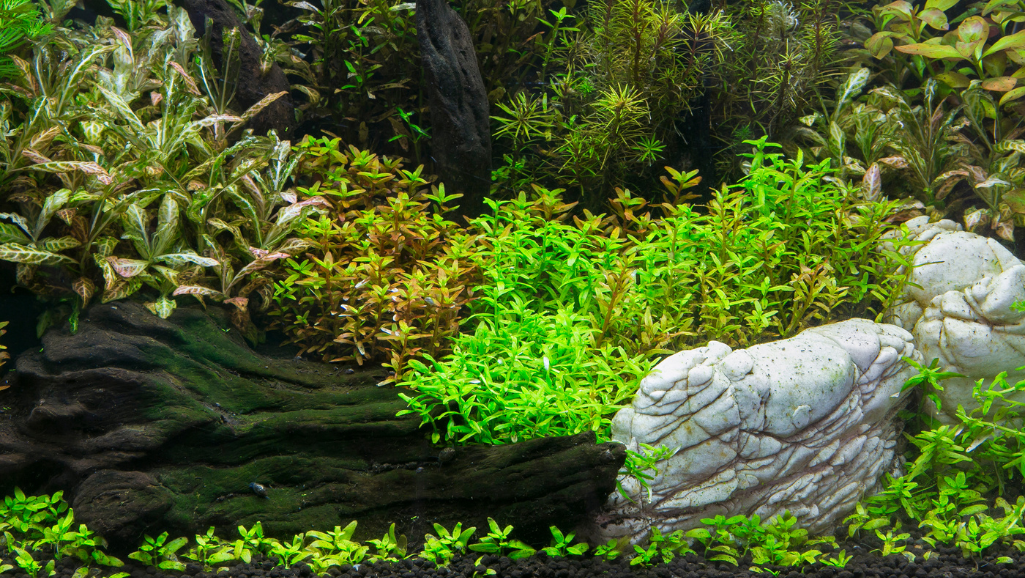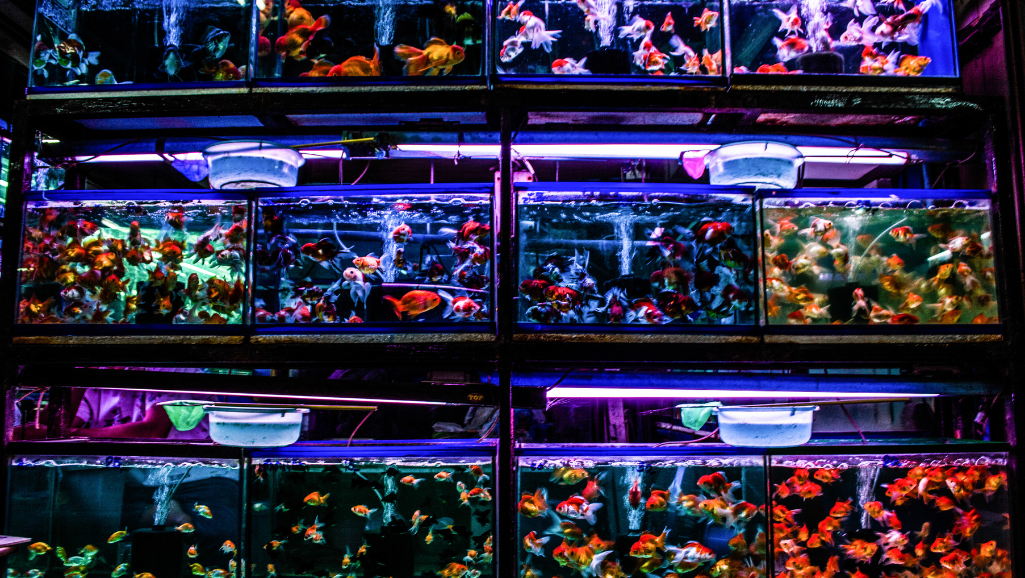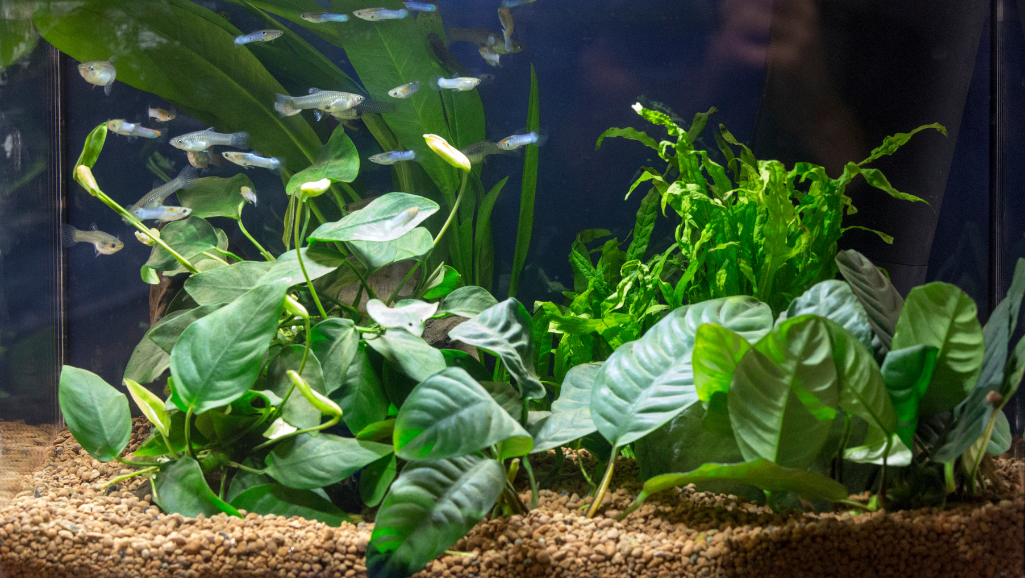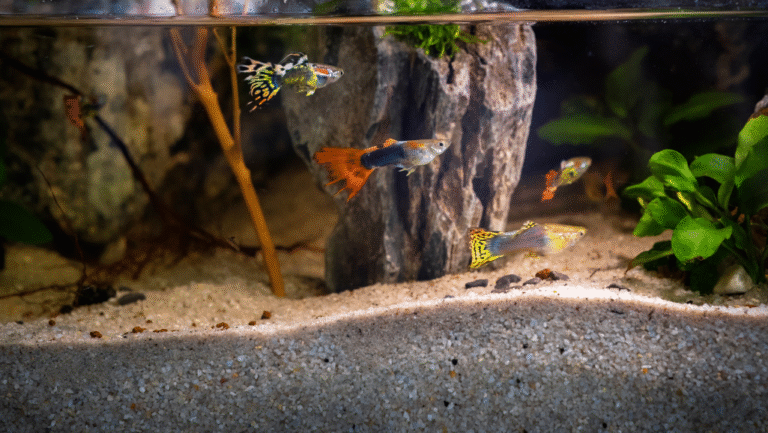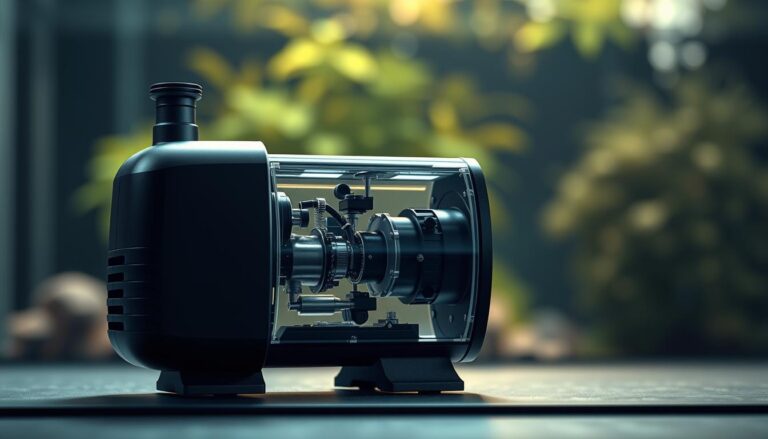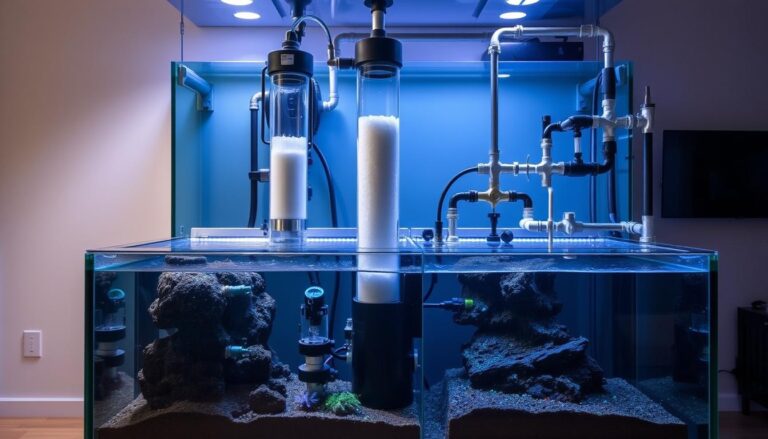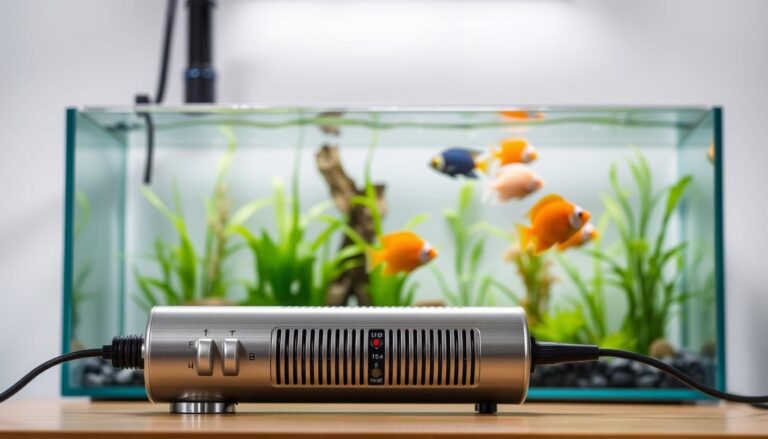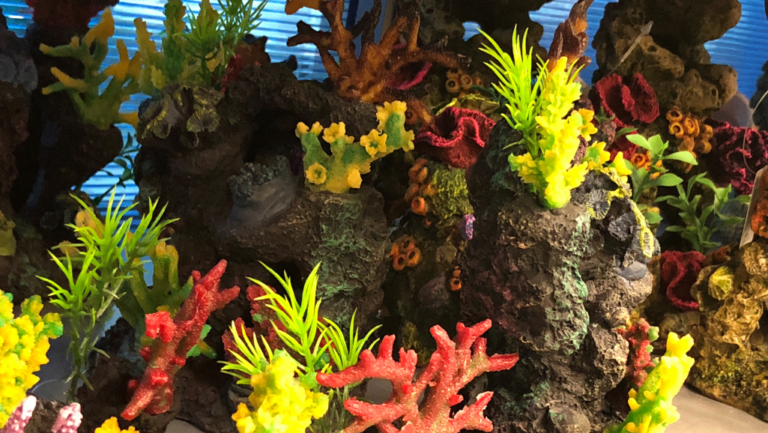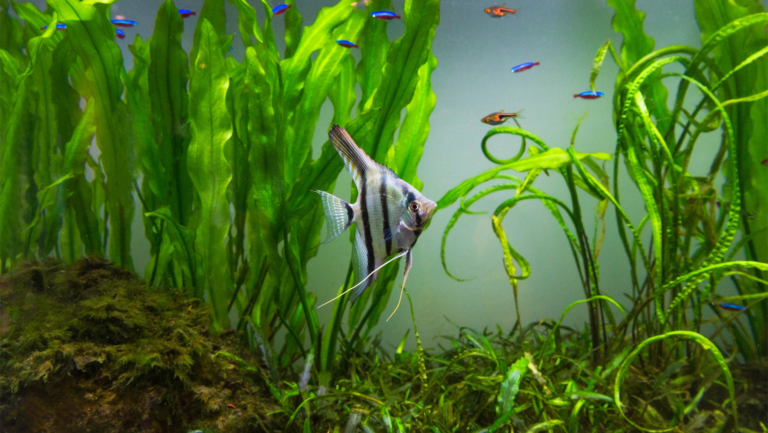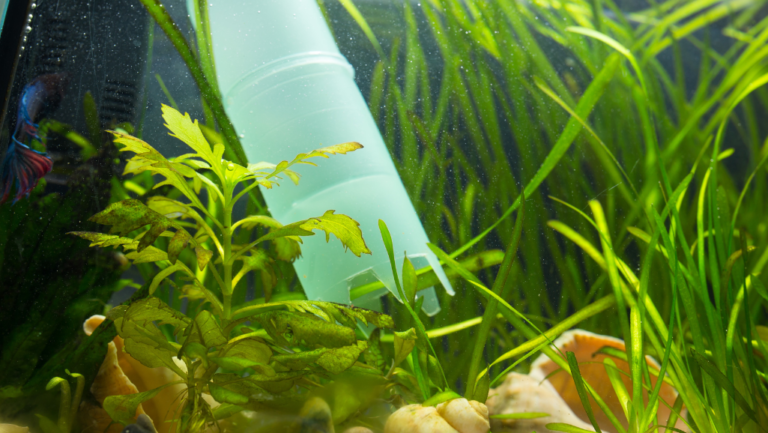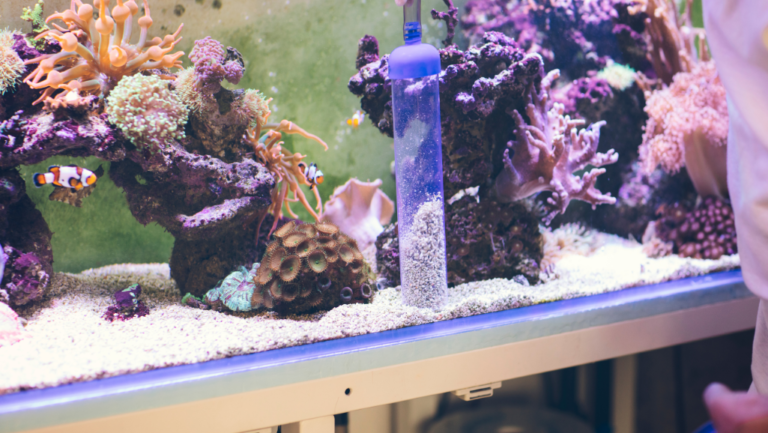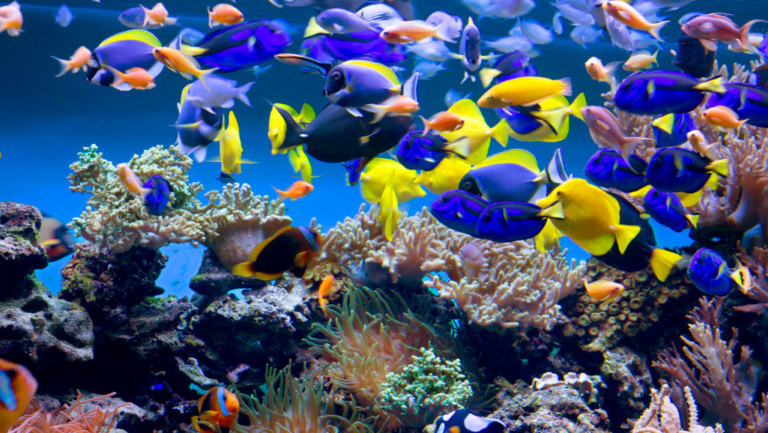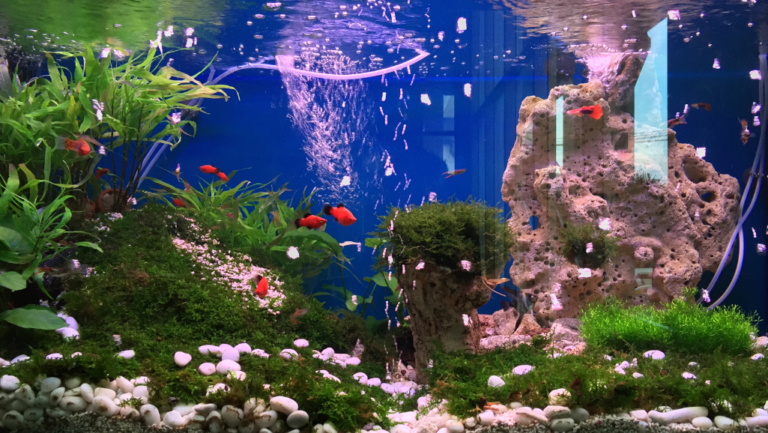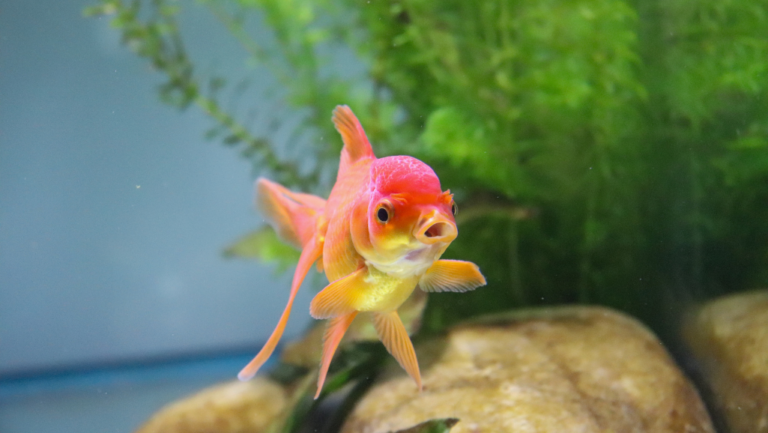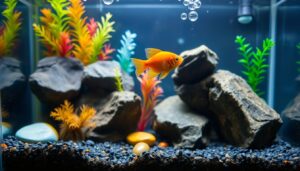Start your journey to create a vibrant underwater world with LED lights. Light is key for your aquarium plants’ health and beauty. This guide will dive into aquarium lighting, focusing on LED technology’s benefits for planted tank lovers.
Picture your plants growing under the perfect light, showing off their colors and health. LED lights are energy-saving, cool, and last a long time. They change how we light our underwater gardens. This guide will help you use LED lights to make a beautiful aquatic space, whether you’re new or experienced.
Choosing the right LED lights is exciting with so many options. There are sleek designs and powerful systems for every aquarium. We’ll look at different LED lights, their features, and benefits, helping you pick the best for your needs and budget.
Exploring submersible grow lights and underwater LEDs shows their power for plant growth. They offer focused light and the right spectrum for your plants to flourish. Your plants will grow lush and vibrant, making your aquarium stunning.
Key Takeaways
- Discover LED Lights for Aquatic Plants – Grow Guide.
- LED lights are the most energy-efficient and long-lasting option for aquarium lighting
- Different types of aquatic plants require varying levels of light intensity, ranging from 10-40+ lumens per liter
- Reflectors can significantly enhance light utilization, increasing efficiency by up to 4 times
- LED lights come in a wide range of sizes and features, catering to various aquarium setups and budgets
- Full-spectrum RGB LEDs can enhance the brilliant colors of freshwater fish and support plant growth
Understanding the Importance of Light for Aquatic Plants
Light is key for growing aquarium plants. It lets them do photosynthesis and thrive. Plants need different amounts of light, from low to high.
When setting up your aquarium, think about the light your plants need. More light means more work, like pruning and fertilizing. Less light means less work and fewer algae problems.
The Role of Photosynthesis
Photosynthesis turns light into energy for plants to grow. Aquatic plants use plant grow lights for this. Without enough light, they can’t make the energy they need.
Light Spectrum Preferences
Plants use all light colors for photosynthesis. But, a red/blue spectrum is best for color. Experts say red lights should be 50% of the spectrum, and blue lights should be 15% or less. This mix helps plants grow well.
“The interplay between light and nutrients is essential for the health of aquatic plants, as an imbalance can lead to issues like algae outbreaks or weak plant growth.”
Daylight Duration Recommendations
The length of daylight is also important for plants. Most plants need 8 hours of light. More than 8 hours can cause too much algae, which harms plants and the aquarium. Aquatic plant bulbs with timers help keep the light right.
Choosing the Right LED Lights for Your Aquatic Setup
Choosing the right LED lights for your aquatic plants is key for a healthy environment. You need to think about tank depth, light intensity, and color spectrum. This ensures your plants grow well and stay healthy.
Types of LED Lights for Aquariums
There are many types of LED lights for aquariums, each with its own benefits. Here are a few:
- White LED bulbs: These give a wide range of light, good for most plants.
- RGB bulbs: With red, green, and blue light, you can change colors.
- RGB-W bulbs: They mix white and RGB, giving you flexibility.
Key Features to Look For
When buying LED lights, look for these important features:
- Adjustable intensity: Choose lights that can dim to meet plant needs.
- Programmable settings: Options like day and night cycles mimic nature.
- Waterproof or submersible options: Make sure lights can handle water.
“Investing in high-quality LED lights is a game-changer for any aquatic plant enthusiast. The right lighting setup can make all the difference in the health and vibrancy of your underwater garden.”
Comparing Brands and Models
There are many brands and models of high-output aquarium lighting out there. It’s important to compare them. Look at color temperature, measured in Kelvin (K). Many prefer light around 5000 to 6500 K, like natural daylight.
Also, check if the light spreads wide, like 120 degrees. This ensures your aquarium gets enough light.
Benefits of Using LED Lights for Aquatic Plants
LED lights have changed how we light our aquariums. They are energy-saving and last a long time. This makes them great for growing plants underwater.
Energy Efficiency Advantages
LED lights use much less power than old lights. This means you save a lot on your electric bill. They cost less than incandescent and fluorescent bulbs.
Switching to LED lights makes your aquarium look good. It also helps the planet and saves you money.
Longevity and Maintenance
LED lights last a long time if they don’t get too hot. This means you won’t have to replace them often. But, they can get damaged by water or salt, so take care of them.
“LED lighting has shown successful coral growth and can enhance coral coloration, making it an excellent choice for reef aquariums as well.”
Enhancing Plant Growth and Health
LED lights are good for plants because they give the right light. They can shine light deep into the water. This helps plants grow well.
LED lights also don’t get too hot. This keeps the water temperature stable. This is good for the plants and helps them grow.
When setting up your aquarium lighting, give plants 8 hours of light a day. You can add more for a better view. Keeping the light schedule the same helps plants and fish grow well.
Designing Your Aquatic Environment with LED Lights
Creating a stunning aquatic environment needs careful planning. This includes the right placement and mix of LED lights. Aquarium lighting is key for healthy plants and a beautiful underwater scene.
When setting up your aquarium, place LED lights wisely. This ensures your plants grow well. Even light distribution makes your aquarium look balanced and natural.
Placement Strategies for Optimal Growth
Here are tips for placing your LED lights:
- Put lights above the tank for even light across the whole area.
- Adjust light height based on your plants’ needs.
- Use spot and bar lights for a layered look.
Combining Different Light Types
Try mixing LED lights for a unique look. You can use:
- White LEDs for general light and natural colors.
- Blue LEDs for a calming moonlight effect.
- Red and green LEDs to boost plant growth.
“The key to a thriving aquatic ecosystem lies in finding the perfect balance of light, nutrients, and care.”
Creating a Balanced Light Schedule
It’s important to have a balanced light schedule. This helps your plants grow. Try to match natural daylight with:
- 12-14 hours of light a day for most plants.
- Gradual light changes to mimic day and night.
- Regular lighting to keep a stable home for plants and fish.
With careful LED light design, you can make a stunning underwater world. Use aquarium lighting to make your planted tank thrive!
Common Myths About LED Lights and Aquatic Plants
Many people believe that a certain amount of watts per gallon of water is needed for plants to grow well. But this idea doesn’t hold up to scientific testing. It doesn’t take into account the complex world of aquatic ecosystems.
Some think that plants need a light with a Kelvin temperature of 6500K. But plants live in many different environments, not all like the bright sunlight of midday.
Addressing Color Temperature Misconceptions
Many believe that very high color temperatures, like above 8000K, are best for plants. But this isn’t true. Even though some LED lights, like the Satellite Freshwater Plus Pro LED, have little red light, a mix of red and blue is better for plants. Research shows that the right amount and type of light are key for plant growth.
“The relative quantum efficiency curve represents the direct effects of radiation spectrum on photosynthesis.” – Research Study
Dispelling Myths About Plant Growth
LED lights can support lush plant growth if you use high-quality, full-spectrum fixtures. The secret is finding the right balance of light intensity and spectrum. This is more important than following old rules like the WPG or 6500K myths.
When choosing your aquarium lighting, think about your tank size, plant types, and ecosystem balance. By ignoring these myths and using science-backed methods, you can make a stunning and healthy aquatic space. This space will support the growth of your plants and fish.
How to Install LED Lights in Your Aquarium
Adding LED lights to your aquarium can make it look amazing and help your plants grow well. The right lighting setup can make your aquarium look stunning and keep your plants healthy. We’ll show you how to install LED lights in your aquarium easily and effectively.
Step-by-Step Installation Guide
First, get all the things you need like your LED lights, mounting brackets, and tools. Follow these steps for a smooth installation:
- Find the best spot for your LED lights. Place them at the top or bottom to avoid hot spots and ensure even light.
- Attach the mounting brackets to the aquarium frame. Make sure they’re level and secure.
- Connect the LED lights to the brackets as the maker says. Make sure the connections are tight.
- Put the LED lights to reflect off the aquarium’s back wall. This makes the light spread out and creates beautiful colors.
- Use your main lights with background LED lights set low. This mix makes your aquarium look amazing and shows off its beauty.
When picking LED lights, think about using submersible grow lights for plants. These lights give the right spectrum and intensity for healthy plant growth.
Safety Precautions to Consider
When working with electricity and water, safety is key. Remember these safety tips during installation:
- Always unplug your aquarium equipment before starting.
- Use waterproof or submersible LED lights to avoid electrical dangers.
- Make sure all electrical connections are sealed and outside the aquarium.
- Check your LED lights often for damage or problems. Replace them right away if you find any.
“Proper installation and positioning of LED lights can make a world of difference in the health and appearance of your aquatic plants. Take the time to carefully plan and execute your lighting setup for optimal results.”
By following these steps and safety tips, you can make your aquarium a thriving and beautiful place with LED lights. Use the power of aquarium lighting to make your plants grow and look their best.
Monitoring and Adjusting Light Conditions
Keeping the right aquarium lighting is key for your plants’ health and growth. Regular checks and tweaks to light levels help your plants thrive. This also keeps algae growth in check.
It’s important to know what light your plants need. Different plants need different amounts and types of light. For example, plants like Dwarf Baby Tears need lots of light to grow well. But plants like Java Fern can do well in less light.
Tools for Measuring Light Intensity
Measuring light intensity is vital for your plants. You can use:
- PAR meters: These measure Photosynthetically Active Radiation (PAR) at different depths and spots in your tank.
- Lux meters: Like PAR meters, lux meters check the visible light intensity. They help you see if your plants have enough light.
“Proper light intensity, duration, and spectrum are key for plant health in aquariums.”
Signs of Inadequate Light Levels
Watching your plants closely can show if they’re not getting enough light. Look out for:
- Stunted growth or slow development
- Pale or yellowing leaves
- Extended stem growth as plants stretch towards the light source
If you see these signs, it might be time to change your plant grow lights or get a better lighting system. Finding the right light balance is important. It helps your plants grow well and keeps algae under control in your aquarium.
Troubleshooting Common Issues with LED Lights
LED lights can sometimes cause problems for your aquatic plants. Issues like light overload and deficiency can harm your plants and the aquarium’s health.
Identifying Light Overload Symptoms
Light overload happens when plants get too much light. This can lead to problems. Look out for:
- Excessive algae growth
- Bleached or burned leaves
- Rapid plant decay
If you see these signs, act fast to protect your plants. Lowering the LED light’s intensity or duration can help. Find a balance that supports plant growth without overloading the ecosystem.
Solutions for Light Deficiency
Light deficiency can also slow down plant growth. Signs include:
- Slow growth
- Leggy stems
- Poor coloration
To fix light deficiency, boost your LED lights’ intensity or add more light. Different plants need different light levels. For instance, low-light plants like Java fern and Anubias do well in dimmer light. But high-light plants, such as Red Ludwigia and Dwarf baby tears, need brighter light to grow well.
“Finding the right balance of aquarium lighting is key to promoting healthy plant growth and maintaining a thriving aquatic ecosystem.”
Keep an eye on your plants and adjust your LED lighting as needed. This way, you can solve common problems and give your plants the best light for growth.
Advanced Techniques for Maximizing Light Efficiency
To make your aquatic plants grow well, you need to use your aquarium lighting wisely. Advanced techniques and the right gear can help. Let’s look at ways to boost light efficiency in your tank.
Using Reflectors and Diffusers
Reflectors and diffusers are key for better light in your tank. Reflectors bounce light back, making it stronger and more even. This is great for high-output lights, helping them shine brighter.
Diffusers spread light evenly, avoiding harsh shadows. This helps plants grow better. Together, reflectors and diffusers give your plants the best light for growth.
Creating a Custom Lighting Schedule
Another smart move is to set up a lighting schedule like daylight. This helps plants grow like they would in nature. It’s all about matching the light to their natural day.
Use programmable LED lights for this. They let you control light color, intensity, and timing. This way, you can give your plants the perfect light for photosynthesis and growth.
“Replicating natural lighting conditions in aquariums increases survival rates and growth rates of aquatic inhabitants.”
Most plants need 10 to 12 hours of light a day. But too much light can cause algae. If algae grows too much, try reducing light to 8 to 10 hours.
With reflectors, diffusers, and a smart lighting schedule, your tank will thrive. These steps improve plant health and make your tank look amazing.
Future Trends in LED Technology for Aquatic Plants
LED technology is leading the way in aquarium lighting, bringing new possibilities for plant lovers. The future looks bright for LED lights in aquariums. Advances in light spectrum and eco-friendly practices will lead to healthier plants and more vibrant tanks.
Innovations in Light Spectrum Management
LED tech now lets us tailor light for different plants. We can adjust the spectrum to meet each plant’s needs. This means better growth and health for all kinds of aquatic plants.
These new LED systems mimic natural light. They offer the right mix of red, blue, and green light. This helps plants photosynthesize and thrive, no matter their light needs.
Sustainable Practices in Aquarium Lighting
LED lights are becoming a green choice for aquariums. They use less power and last longer. This makes them a key part of eco-friendly aquarium lighting.
LEDs are made from recyclable materials and have modular designs. This reduces their environmental impact. Plus, smart features like automatic dimming and remote control help save energy. They ensure plants get the best light for growth.
The LED Aquarium Lighting Market is set to grow fast. It’s expected to reach $1 billion by 2032, growing at 12% annually. As LED tech improves, we’ll see more efficient, customizable, and sustainable lighting. This will help us create stunning, thriving aquatic plant displays.
